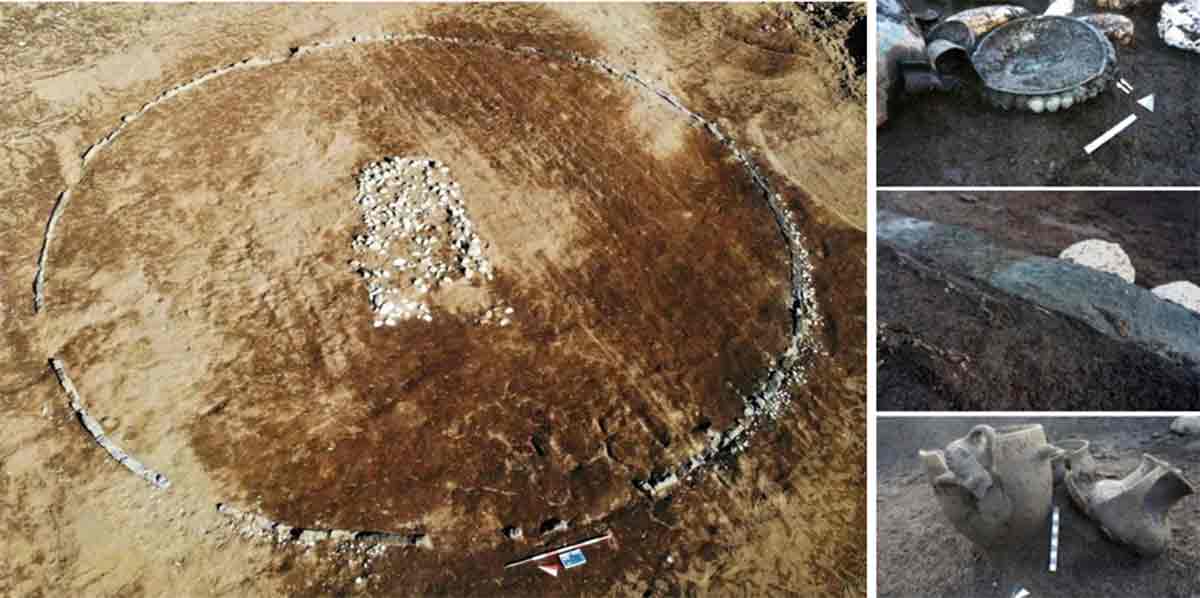2,700-Year-Old Iron Age Pit Tomb Necropolis Unearthed in Italy
During excavations launched ahead of an upcoming electric power plant construction project, archaeologists unearthed an approximately 2,700-year-old necropolis about 31 miles (50 kilometers) northeast of Naples, Italy. The fascinating discovery was announced in a press release issued by the Superintendency of Archaeology, Fine Arts, and Landscapes for the provinces of Caserta and Benevento, which has been managing the archaeological work at the construction site.
“Although the excavation of the site has brought to light various levels of occupation, from prehistoric times to late antiquity, the best-preserved archaeological evidence concerns the large funerary area, which was used between the final phases of the Iron Age and the advanced Orientalizing period (third quarter of the eighth – second half/end of the seventh century BC),” the Superintendency press release (translated from Italian) stated.
Interestingly, the installation and use of the large cemetery coincides with the founding of the city of Rome, which according to legend occurred in 753 BC. But the Iron Age culture responsible for this burial ground had no direct connection with the Romans or with Rome, which was located 120 miles (200 kilometers) away.
- Iron Age Europe: 2000 Years Of Change Rolls Across The Continent
- Forging a Nation: The Iron Age Tribes of Britain
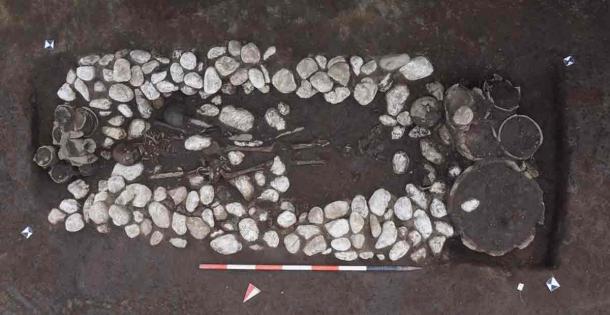
One of the burials at the site. (Superintendency of Archaeology, Fine Arts and Landscape)
Italy’s Iron Age Pit Tomb Culture Revealed
This vast Iron Age graveyard covers 140,000 square feet (13,000 square meters) of open field. It was unearthed in a spot just outside the village of Amorosi (Benevento), in the Telesina Valley not far from the banks of the Volturno River.
So far excavations have unearthed human remains in 88 burials, all of which are representative of the burial practices of the so-called “Pit Tomb” culture that occupied this part of ancient Italy during the eighth century BC. The pit tombs these people favored were holes dug into the ground surrounded by rock-lined walls on each side, which were wide enough to create space for not just the bodies of the deceased, but for the grave goods that would be buried alongside them to make their journey to the afterworld more comfortable and convenient.
- Neolithic Skeleton “Lovingly Buried” in Fetal Position
- Elaborate 8,000-year-old Necklace from Child Burial Reveals Ancient Culture
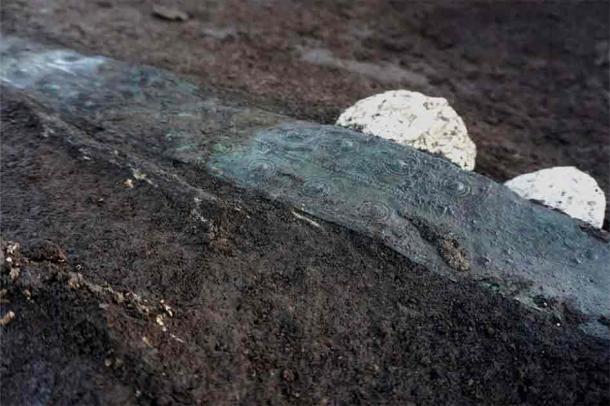
A weapon found in one of the male graves. (Superintendency of Archaeology, Fine Arts and Landscape)
The burial ground featured skeletons of both men and women. The men were mostly buried with weapons, while the women were entombed with ornaments and jewelry of different types, including bracelets, brooches, pendants, amber pieces and various personal items made from bone. Ceramic pottery of various shapes and styles was also found in several of the burials.
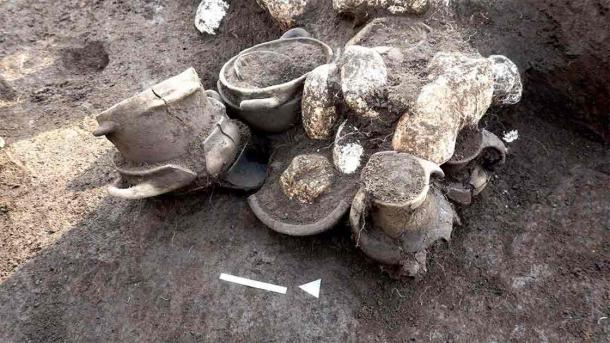
Ceramics recovered from one of the graves. (Superintendency of Archaeology, Fine Arts and Landscape)
Once they’d unearthed the pit tomb graves, the archaeologists involved in these excavations began to look more closely at two impressive burial mounds that can be found adjacent to the tombs. Easily visible on the earth’s surface, these large mounds are about 50 feet (15 meters) in diameter and surrounded by stone circles. It is believed these mounds would have been reserved for the burials of highly important or influential people, possibly chieftains or those who had accumulated a great deal of wealth.
It was the existence of these mounds that alerted archaeologists to the possibility that more ruins might be found at the Telesina Valley site. But they were still surprised to discover a sprawling Iron Age cemetery in the same general location.
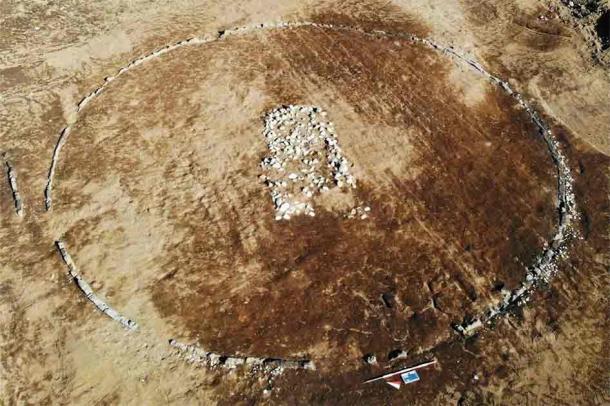
One of the burial mounds with the burial in the center and encircled by stones. (Superintendency of Archaeology, Fine Arts and Landscape)
Unearthing the Buried Cultures of Pre-Roman Times
The legend credits the mythical hero Romulus with the creation of Rome in 753 BC. According to historians and archaeologists, however, the origins of Rome likely go back further in time, when various small villages in the region decided to pool their resources and band together to protect themselves from outside invaders in the 10th century BC.
Even before their emergence as a Republic and an Empire, the Romans were expansionist and aggressive. They battled many different city-states in their quest for regional supremacy, and starting in the fourth century BC the Romans clashed with the neighboring Samnites on numerous occasions. The Samnites occupied lands to the south and east of Rome, in the rugged and mountainous Apennine region, their territory overlapping with the mysterious groups responsible for the formation of the Pit Tomb culture.
Despite sharing the same territory, however, it seems the builders of the pit tombs were not earlier versions of the Samnites. They were instead a unique indigenous culture that occupied the region before being displaced by the Samnites, who unlike the Pit Tomb people were destined to become a recognized enemy of Rome.
Like all the other peoples on the Italian peninsula, the Samnites were eventually defeated and occupied or displaced by the Roman conquerors, who brought cultural unity to what would become the nation of Italy in future centuries. By this time, though, the Pit Tomb culture had already disappeared over the distant horizon of history, forgotten about almost completely until their memory was resurrected many centuries later by archaeologists who began unearthing their burial grounds all over central and southern Italy.
Archaeologists affiliated with the Superintendency of Archaeology, Fine Arts, and Landscapes will be increasing their activity at the Pit Tomb culture site where the Iron Age cemetery has been found, so they can complete a more in-depth study of the tombs, mounds and artifacts before the power plant construction project commences.
While the skeletal remains and artifacts may eventually be removed and transferred to museums and universities, special steps will have to be taken to ensure the burial mounds are not damaged or destroyed by construction-related activities. Both Superintendency officials and the village government in Amorosi seem prepared to do this, recognizing the cultural value of these ancient pre-Roman sites.
Top image: Left; One of the mound burials, Right; A selection of grave goods from the necropolis. Source: Superintendency of Archaeology, Fine Arts and Landscape
By Nathan Falde















